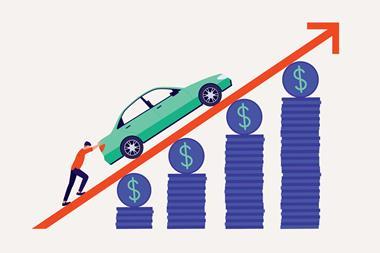The industry and technology has moved on from the traditional notion of a black box, but are customers finally seeing the advantages of telematics motor insurance policies?
The excited press coverage of Aviva’s introduction of the first UK telematics motor insurance product in 2005 suggested that a revolution was underway.

Policyholders of this revolutionary product were offered the chance to achieve dramatic premium discounts in return for installing a ‘black box’ in their vehicle that used GPS technology to relay data about their driving to the insurer. The safer their driving was considered, the more they could save.
The approach has certainly proved attractive to drivers aged under 25, but elsewhere it has largely fallen on deaf ears. Mike Brockman, chief executive and founder of telematics firm ThingCo, estimated that overall tlematics market penetration in 2023 sat in the region of between 5% and 6%.
Even Aviva admitted that its initial foray into the world of telematics came at a time when the market wasn’t ready, when customers didn’t seem to want telematics and insurers didn’t seem to understand how to leverage it.
Fears that the information being recorded could get into the wrong hands – and the feeling that having to install devices was simply too much hassle – have proved major barriers to widespread customer adoption.
Matthew Connell, director of policy and public affairs at the Chartered Insurance Institute (CII), said: “There is the general idea of [customers] not wanting an insurance company looking over [their] shoulder, although this has been much less of an issue for young drivers, who otherwise simply couldn’t afford insurance.
“[For young people], it’s often their parents, who are not the ones being spied on, who are paying the premiums.
“Our consumer research shows that ease of doing business is a more important consideration than price when buying insurance. The pain of paying a bit more tends to be less than the pain of installing new technology or waiting for things through the post. People just want to get the purchase out of the way and forget about it for a year.”
New dawn?
Despite this reported aversion from consumers, there is a feeling from some in the market that the sector has now reached an inflection point that will see the floodgates open as telematics finally starts to appeal to older drivers.
Read: Howden announces UK launch of telematics service to help cut motor premiums
Read: Aviva launches new young driver insurance product
Explore more telematics-related content here or discover other news analysis stories here
Mike Brockman reported that ThingCo’s business volumes have risen by over 50% during the last few months and said he felt “more optimistic about the future of telematics than ever before”.
Not only are soaring motor insurance premiums and the wider cost of living crisis leading customers to increasingly look for savings, but telematics providers are coming out with more user-friendly versions of their technology than the traditional black box.
While Aviva still offers a black box version, in November 2022 it launched an ‘app and tag’ option, requiring the installation only of a small matchbox-sized device behind the rear-view mirror. This product targets a broader age of young drivers, up to those aged 29.
Additionally, since this April, Aviva has been trialling an app-only approach with a small segment of policyholders. This is embedded within the MyAviva app and requires no installation at all.
Also avoiding the need to install a box, Admiral, in partnership with Ford Smart Mobility and Redtail Telematics, launched a connected car telematics product this May. It enables customers owning a Ford vehicle with a FordPass Connect Modem manufactured from 2021 onwards to share driving data collected directly from their car.
A pay-by-mile approach, although still requiring a black box, has been playing a further part in making telematics more affordable to older drivers. The fact that pay-by-mile insurer By Miles was acquired by Direct Line this April is proof enough of the potential detected by major motor insurers.
Andrew Little, head of marketing and sales at Redtail Telematics, said: “Typically, the cost of a box and related services limited telematics to drivers with premiums of above £1,500, but the tipping point is being forced by the simpler proposition of By Miles and the lower cost of approaches not involving a black box, including connected vehicle products.
“This opens it all up to the mass market. It will take a while, but these new developments will reduce the costs of telematics to insurers by 75%. In 10 years’ time, I hope that at least 50% of the whole motor market will make use of at least some telematics data.”
Education needed
But, despite these cost improvements in the telematics proposition, such a target is unlikely to be achieved unless insurers communicate their educational messages more effectively.
“The Big Brother thing is always prevalent in our consumer research,” continued Little, “but it’s a misconception – only anonymised journey data is used, not personal data.”
Insurers also need to do better at explaining what policyholders gain from allowing insurers to utilise telematics data gathered from their vehicles.
Little added: “As well as saving on premium by the insurer being better informed of the risk, people should realise that driving in a lower-risk manner reduces fuel consumption, which lowers both fuel costs and carbon emissions, so there is a green angle.
“We can also provide instant digital proof of what happened at an accident, which can save policyholders and insurers considerable time and money in legal wranglings.”
Telematics providers could undoubtedly help their educational cause by coming up with more persuasive statistics, particularly those that could illustrate the frequently-asserted notion that telematics results in safer driving.
Evidence offered in support of this tends to refer only to an overall drop in young driver accidents during the telematics era. For example, Department for Transport statistics show that the numbers of those killed or seriously injured from a collision involving at least one young car driver – aged 17 to 24 – fell by 64% between 2004 and 2021.
Telematics undoubtedly contributed, but so possibly did other factors like improvements in vehicle design and lower road usage due to Covid.
Hosted by comedian and actor Tom Allen, 34 Gold, 23 Silver and 22 Bronze awards were handed out across an amazing 34 categories recognising brilliance and innovation right across the breadth of UK general insurance.




















































No comments yet